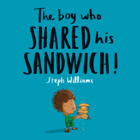
“If God is everywhere, is he in the bookshelf?” our then-five-year-old asked.
“Um, not exactly…” I replied, “Or maybe yes, since he is everywhere? ... But then again, we’re not pantheists, he’s not in a plank of wood ... You know, I’ll get back to you on that!”
How had I not thought to research how God’s omnipresence intersects with pantheism before our bedtime Bible stories?!
Family Bible times don’t always go where we expect them to. To be honest, sometimes they don’t even start how we intend! Someone is shoving their brother, another child only seems capable of being upside down… Their attention span is suddenly so short! And yet the Bible is full of gripping true stories, entertaining illustrations, and of course is God’s life-changing word.
So is Bible time distraction just a spiritual battle, or can we do more to help?
"When Jesus and the Old Testament prophets communicated God's Word, they also used engaging communication methods like stories, pictures, questions, and drama."
First, let’s remember that it is God who opens our eyes to his truth (2 Corinthians 4:4). How often do we pray for family Bible times or for God to speak to our children? Maybe we need to pray more.
However, alongside the Spirit’s work, God has given us a part to play. We have the privilege of using our gifts and minds to communicate his word well. When Jesus and the Old Testament prophets communicated God's Word, they also used engaging communication methods like stories, pictures, questions, and drama. They used attention-grabbing illustrations, like dinner cooked over poo (Ezekiel 4), or prophets taking back an unfaithful wife (Hosea). They used humour, such as Jesus’ point about removing the plank from your eye before removing the speck from someone else’s (Mattthew 7:3-5). In Matthew 18, Jesus didn’t say to his disciples, You know, you should really be more humble. He didn’t even just say, You need to be like a child. No, he put a child in front of them. He used creative, visual means not just clear, logical explanation.
In these examples and so many more, God didn’t just expect those he was trying to reach to pay attention. He had every right to, and they should have done so, but in his amazing grace and love he fought to get their attention; he went to find and win them!

An engaging retelling of the feeding of the 5,000 that helps young children discover how Jesus gives life that lasts for ever, not just for now!
If God valued creativity and visual illustration in spiritual communication, shouldn't we? And while it’s good to train our children to listen, I wonder if the length of time that children can sit still and concentrate is really God’s first priority? If saying less means more can go in, we should do so!
One reason I started writing the Little Me, Big God Bible stories was because at the time, the Bible story-books we had were dated in style, and the language and amount of text was not age-appropriate. The books were biblical but the value of this was lost on the children as they couldn't take it in! They were always asking, “Can’t we have another ‘play’ story, not a Bible story?!”
I can honestly say that now that I’ve found artistically better, biblical Bible stories (and written my own), our children are asking for them. (And that's not just to look for spurious cats and dogs in the illustrations that probably shouldn’t be there!)
There are also many other creative ways to engage our children. Make the format fit your family! Here are a few ideas …
Read straight from the Bible, but bring out and discuss the shock, fascination, drama, etc in the content. Passages such as The Sermon on the Mount are great for this, or James’ point about how we can tame a large animal, but not our tiny tongue muscle! Read the Bible with the energy you’d read Oi Frog! (by Kes Gray and Jim Field)!
Ask your children to look out for things in the verses as you read them, or write down the most repeated word (and explain that this helps us see what the main point of the passage is).
Express what you've learned in drawings (e.g. Barbara Reaoch’s family devotions have journaling space included).
Ask questions and help your kids get to the meaning themselves (a good tactic whenever they've stopped listening!).
Ask older ones to lead family Bible times (e.g. involve them by allowing them to read the passage, the questions, or support them as they share what the Bible is teaching them).
Watch or discuss Christian cartoons. Ask if the point of the video is true to the meaning of the verse used.
Sing Christian children's songs from YouTube. We're not just trying to teach head knowledge of the Bible—so find songs with lyrics that don’t just tell the facts but express praise and response.
Ask your child questions about the pictures in Bible story-books, such as how they would have felt in the character's shoes.
Around 8 years and older, offer personal bible notes, such as XTB, as well as family times. These provide time between just them and God, and include fun activities. Our children have told us about how God has challenged them through these personal studies.
Let your kids see what Bible verses mean to you outside of family Bible times. Talk about what God has been teaching you in your own Bible study. Remember that you teach the Bible's truth is through your own example. This sounds terrifying (certainly to me at least!), but remember, we follow God in His strength not our own. He wants to help us. So this can be a great incentive to do something about our own spiritual health, and find the support we need from church!
Give biblical perspectives in everyday life. Use your children’s own challenges and experience at school/with friends etc and help them to see if from a Christian perspective. With our own children, asking individually at prayer times whether anything has made them happy or worried at school has brought out things we would never have known about.
During the lockdowns many Christian artists have put great content online and here are more and more quality Christian storybooks available. Why not explore these!
Connect what your children are learning in Sunday School (when it is back in person) to your chats at home!
Let's enjoy this amazing privilege we have as parents, grandparents, family and friends, of helping our children discover the Bible's truths and grow!